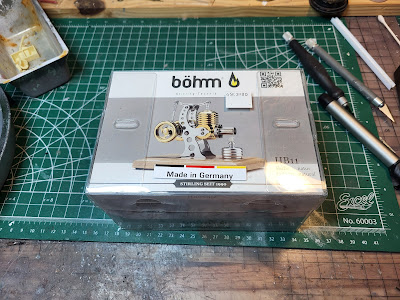And now for something completely different! The Stirling engine, invented in 1816 by Robert Stirling, converts thermal energy of a fuel to mechanical energy of a flywheel. In this sense the Stirling cycle is similar to the Rankine, Otto and Diesel cycles (steam, gasoline and diesel engines respectively). Like the Rankine cycle, it involves external combustion, meaning the fuel is burned outside the cylinders that convert the expanding gas to mechanical motion; but unlike the Rankine cycle, no high-pressure steam is generated. Rather the process is a closed-cycle loop involving a gas (air, in the case of early Stirling engines) which is in turn heated and cooled, pushing and pulling on a pair of pistons as the temperature is varied.
This kit, produced by Böhm of Germany and sold by Lee Valley Tools, comes with all components machined and ready for assembly; it also includes a fuel reservoir and wick designed to take ethyl alcohol. (I may substitute propyl alcohol as it is available at 99% locally, versus only 70% for ethyl alcohol.)
As the air used as a working fluid is at atmospheric pressure, there are no safety issues around potential explosions as there might be with a steam engine operating at high pressure; the only safety issues will be hot surfaces and an open flame.
Stay tuned! This could be interesting.



No comments:
Post a Comment